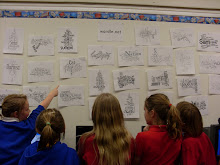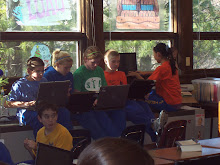The teaching strategies used in this course definitely complimented the integration of technology. Reading about 2.0 tools or studying terms and being tested afterward would have been overwhelming. People who feel that technology is not their thing or over their heads, probably have only heard and read about using certain tools. But once you have step by step instructions, meaningful projects, and fun assignments, it's obvious how easy to use and time saving these tools really are! I had always been intimidated by using Excel formulas. There was no good reason for this. It just remained a mystery to me until last month when we had to create a spreadsheet. This was such a simple assignment but given the same task last year, I would have decided it was easier just to do the math calculations manually and enter them in.
After completing this course I personally define technology integration as the ability to use technology in the classroom to enhance the learning experience and prepare students for future success. Technology integration is not just allowing students to use the computer or other tools. It is creating lessons that use computers, software programs, and the Internet and providing a meaningful learning experience. The goal of technology integration should be teaching students in a way that allows them to save time, enjoy learning, and be ready for careers that involve technology.
Wednesday, May 20, 2009
Thursday, May 14, 2009
Week 7 Effective Technology Integration
“Technology is used as an education tool to support learning goals. It not just a big calculator and is not used primarily to drill students. Instead, effective technology integration teaches students how to problem solve, how to think.” (Dean, 2008)
As I reflect on my learning so far in EDU 554, I’m applying many of the skills we’ve used in the course in my classroom. I’m using a class website now. In just the past seven weeks I have exposed my students to Wordle.net, digital photography, Excel spreadsheets, digital storytelling, and blogs. This class has supplied me with many new instructional ideas in the area of technology. Many of the Expert Reports created by fellow classmates included great recommendations for websites, software, and other multimedia resources. I’m looking into several virtual field trips right now and I’m introducing podcasts to the 5th and 6th grade students next week.
I expect my students will be affected positively by the changes and additions to my computer classes these past two months. The forms of technology I have integrated into our lessons are interactive and have real world relevance. Drill and practice exercises on the computer can be helpful but they are not as engaging as many of these new tools. These forms of technology also promote higher order learning, give students choices, and require more student problem solving. The result is students who come to class excited about technology and eager to learn the next new thing!
As I reflect on my learning so far in EDU 554, I’m applying many of the skills we’ve used in the course in my classroom. I’m using a class website now. In just the past seven weeks I have exposed my students to Wordle.net, digital photography, Excel spreadsheets, digital storytelling, and blogs. This class has supplied me with many new instructional ideas in the area of technology. Many of the Expert Reports created by fellow classmates included great recommendations for websites, software, and other multimedia resources. I’m looking into several virtual field trips right now and I’m introducing podcasts to the 5th and 6th grade students next week.
I expect my students will be affected positively by the changes and additions to my computer classes these past two months. The forms of technology I have integrated into our lessons are interactive and have real world relevance. Drill and practice exercises on the computer can be helpful but they are not as engaging as many of these new tools. These forms of technology also promote higher order learning, give students choices, and require more student problem solving. The result is students who come to class excited about technology and eager to learn the next new thing!
Wednesday, May 6, 2009
Week 6 Multimedia Instructional Materials
Multimedia instruction has the ability to encourage a classroom culture of tolerance, diversity, and freedom of opinion. My goal with using multimedia teaching is that students will learn more deeply from materials involving words, illustrations, narration, and animation. With this learning comes an awareness of people and events outside of our classroom, city, and country.
When I start planning a lesson involving multimedia instructional materials I explore what methods will be most successful in developing this culture of tolerance and awareness. For example, this past week I used www.tumblebooklibrary.com with my kindergarten and first grade students. I began the lesson with a question about summer travel plans. Some students were traveling very far and some had no travel plans at all. Then I asked the class if there were other ways to explore new lands and cultures without getting in a car or on a plane. Many students raised their hands and named books, computers, and movies as a way to experience new places. I then allowed students to go to the travel and culture section in the Tumble Book Library Internet site. The students read and listened to books about Canada, Florida, Mexico, and Australia. The animation really engaged the students and they were eager to take the Tumble quizzes after each story.
There are challenges to using multimedia instructional materials. Proper time and research should go into exploring the validity of programs used in the classroom. Some materials may be expensive or may need to be shared among school staff. But many of these challenges are outweighed by the relative advantage for the teacher, enthusiasm of the students, and the promise of more meaningful learning experience for children.
When I start planning a lesson involving multimedia instructional materials I explore what methods will be most successful in developing this culture of tolerance and awareness. For example, this past week I used www.tumblebooklibrary.com with my kindergarten and first grade students. I began the lesson with a question about summer travel plans. Some students were traveling very far and some had no travel plans at all. Then I asked the class if there were other ways to explore new lands and cultures without getting in a car or on a plane. Many students raised their hands and named books, computers, and movies as a way to experience new places. I then allowed students to go to the travel and culture section in the Tumble Book Library Internet site. The students read and listened to books about Canada, Florida, Mexico, and Australia. The animation really engaged the students and they were eager to take the Tumble quizzes after each story.
There are challenges to using multimedia instructional materials. Proper time and research should go into exploring the validity of programs used in the classroom. Some materials may be expensive or may need to be shared among school staff. But many of these challenges are outweighed by the relative advantage for the teacher, enthusiasm of the students, and the promise of more meaningful learning experience for children.
Subscribe to:
Comments (Atom)




